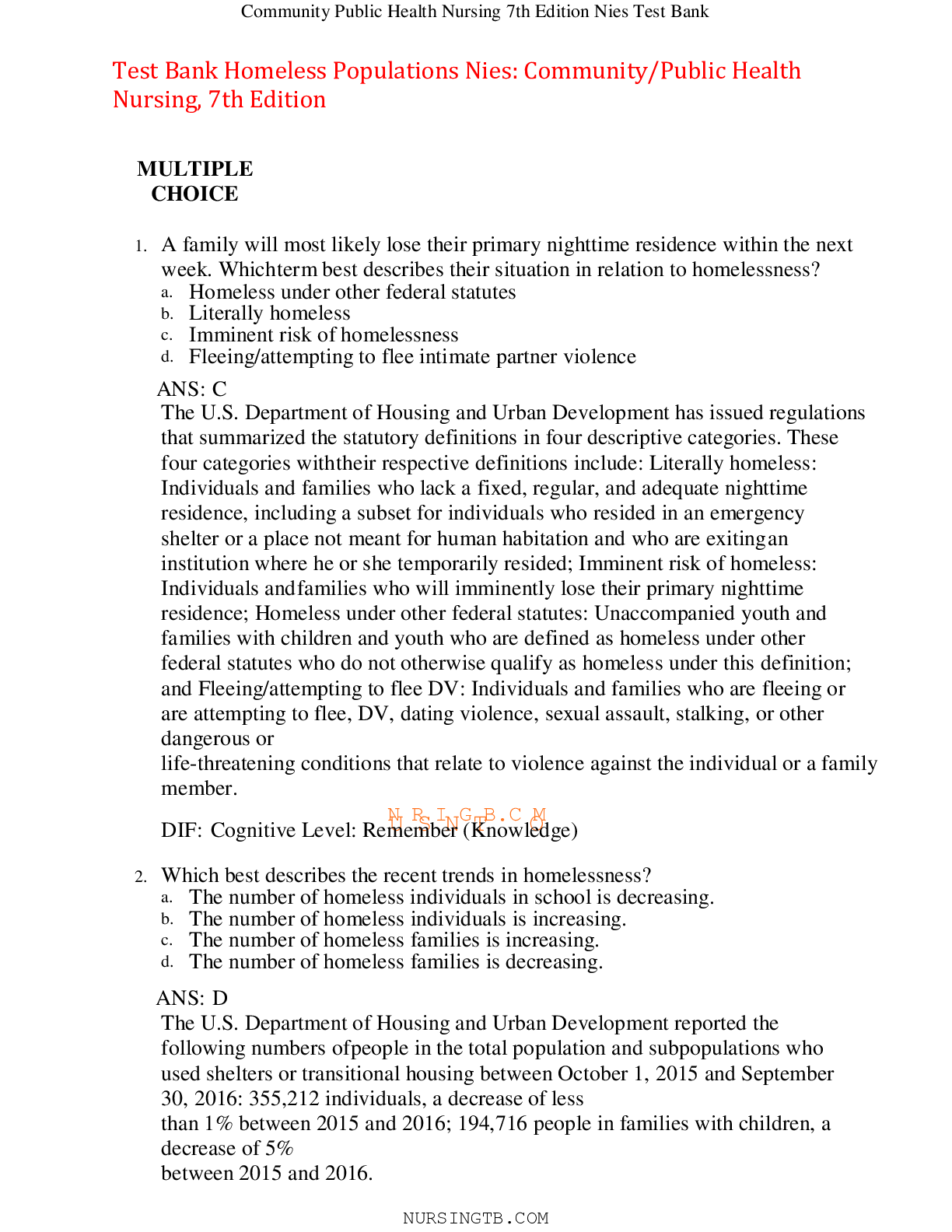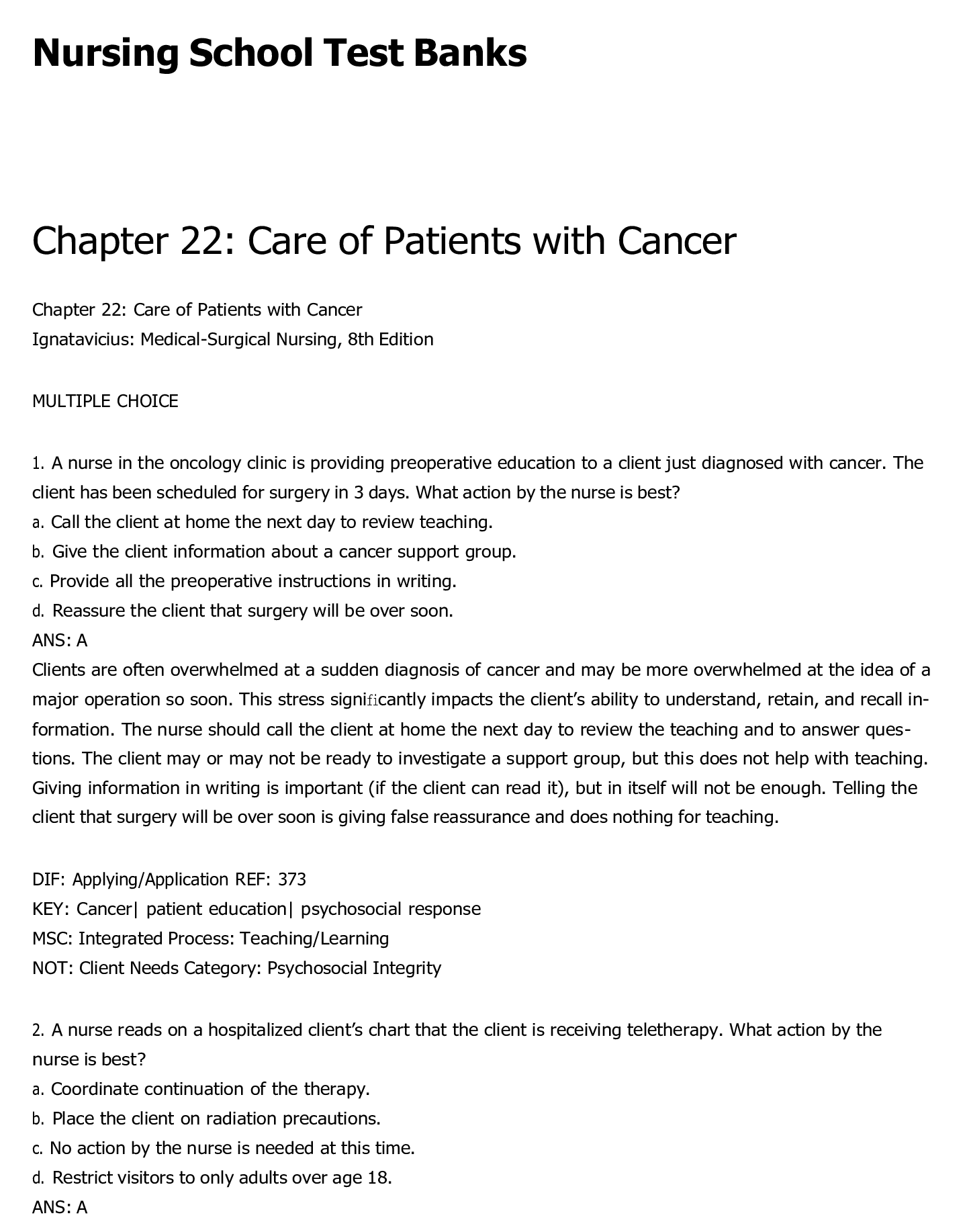*NURSING > TEST BANK > Chapter 51: Care of Patients with Ear and Hearing Problems Test Bank,100% CORRECT (All)
Chapter 51: Care of Patients with Ear and Hearing Problems Test Bank,100% CORRECT
Document Content and Description Below
Chapter 51: Care of Patients with Ear and Hearing Problems Test Bank MULTIPLE CHOICE 1. The nurse is caring for a client with external otitis. Which assessment finding indicates to the nurse t... hat the client’s infection has worsened? a. The client now reports tinnitus and vertigo at night. b. The client now has a positive Rinne test, with AC > BC. c. The tympanic membrane is pearly gray with white patches. d. The auricular lymph nodes have increased in size over the last 24 hours. ANS: D Enlargement of the auricular lymph nodes indicates that the client’s external otitis is becoming more widespread and that current therapy is insufficient. Tinnitus, vertigo, and a positive Rinne test all indicate middle to inner ear problems not related to external otitis media. The tympanic membrane is normally pearly gray in color. White patches on the tympanic membrane are called tympanosclerosis and generally have no clinical importance. DIF: Cognitive Level: Application/Applying or higher REF: N/A TOP: Client Needs Category: Physiological Integrity (Physiological Adaptation—Pathophysiology) MSC: Integrated Process: Nursing Process (Assessment) 2. The nurse is caring for a client with a furuncle on the pinna at the opening of the ear canal. The nurse is reviewing home care instructions with the client. Which statement by the client indicates that additional teaching is needed? a. “I will put the bacitracin ointment on the sore three times a day.” b. “I will gently squeeze the sore to drain the liquid out once a day.” c. “I will take Tylenol (acetaminophen) if my ear starts to hurt a lot.” d. “I will put a warm compress on the sore for 15 minutes three times a day.” ANS: B Compressing or squeezing the furuncle can traumatize tissues and can force infective material deeper into the tissue layers, spreading the infection. Tylenol may be taken to reduce pain, and a warm compress will facilitate drainage and healing of the furuncle. Bacitracin ointment is an anti-infective and will help clear the infection. DIF: Cognitive Level: Application/Applying or higher REF: N/A TOP: Client Needs Category: Physiological Integrity (Physiological Adaptation—Illness Management) MSC: Integrated Process: Nursing Process (Evaluation) 3. The nurse is caring for a client with otitis media. The client reports that the pain was severe during the night but was gone upon awakening in the morning. Which finding does the nurse expect to observe during the client’s physical assessment? a. The tympanic membrane is bluish-gray. b. Purulent fluid is present in the ear canal. c. The pinna and the tragus are reddened and swollen. d. Sounds are lateralized toward the affected ear. ANS: B Spontaneous perforation of the tympanic membrane during acute otitis media relieves the pressure on middle ear structures and results in a sudden decrease in or elimination of pain. Purulent drainage is often present in the ear canal as the fluid drains away from the tympanic membrane. Bluish-gray coloring of the tympanic membrane indicates blood behind the eardrum. A reddened pinna and tragus indicate otitis externa. Lateralization of sounds toward the affected ear would not be expected. DIF: Cognitive Level: Application/Applying or higher REF: N/A TOP: Client Needs Category: Physiological Integrity (Physiological Adaptation—Pathophysiology) MSC: Integrated Process: Nursing Process (Assessment) 4. The nurse is caring for a client with otitis media and notes purulent drainage in the ear canal during the physical assessment. Which is the nurse’s priority intervention? a. Obtain a specimen of the drainage for culture. b. Irrigate the ear canal with sterile normal saline. c. Gently examine the client’s ear with an otoscope. d. Place a cotton ball in the ear canal to absorb the drainage. ANS: C The nurse should use an otoscope to determine whether the client’s tympanic membrane has ruptured. Until the tympanic membrane is examined and is found to be intact, syringing is not performed. A specimen is obtained only if the infection has failed to respond to standard antibiotic therapy. A cotton ball should not be placed in the ear canal to absorb the drainage. DIF: Cognitive Level: Application/Applying or higher REF: N/A TOP: Client Needs Category: Physiological Integrity (Physiological Adaptation—Illness Management) MSC: Integrated Process: Nursing Process (Assessment) 5. A client with a ruptured tympanic membrane asks the nurse whether hearing will be affected permanently. Which is the nurse’s best response? a. “Possibly. The eardrum usually heals in 1 to 2 weeks. Any persistent hearing problem should be evaluated.” b. “No. Antibiotics will help resolve the infection and cure your hearing impairment.” c. “Yes. It will be important for you to be fitted with a hearing aid as soon as possible.” d. “Yes. Any time the eardrum is ruptured it will form a scar, which will cause some degree of permanent hearing loss.” ANS: A An uncomplicated rupture of the tympanic membrane usually heals spontaneously within 1 to 2 weeks and does not result in a permanent hearing impairment. Antibiotics may not be effective in restoring hearing fully. Hearing aids may be prescribed for the client only if hearing loss is determined to be permanent. DIF: Cognitive Level: Application/Applying or higher REF: N/A TOP: Client Needs Category: Physiological Integrity (Reduction of Risk Potential—Potential for Alterations in Body Systems) MSC: Integrated Process: Teaching/Learning 6. The nurse is caring for a client with Ménière’s disease. The client asks the nurse how to prevent another acute episode from occurring. Which is the nurse’s best response? a. “Stop or reduce cigarette smoking.” b. “Use aspirin rather than acetaminophen (Tylenol) for pain.” c. “Reduce the quantity of saturated fats in your diet.” d. “Avoid crowds and people with upper respiratory infection.” ANS: A The vasoconstrictive effects of cigarette smoking promote acute episodes of Ménière’s disease. Aspirin and other NSAIDs can be ototoxic and should be avoided. Avoiding saturated fats and people with upper respiratory infection will not help prevent a recurrence of Ménière’s disease. A hydrops diet may stabilize body fluid levels to prevent excess endolymph accumulation. DIF: Cognitive Level: Comprehension/Understanding REF: p. 1096 TOP: Client Needs Category: Physiological Integrity (Physiological Adaptation—Illness Management) MSC: Integrated Process: Teaching/Learning 7. When performing a client’s physical assessment, the nurse notes that the client has conductive hearing loss. Which finding does the nurse expect to see in the client’s medical history? a. History of diabetes with peripheral neuropathy b. Frequent episodes of otitis media during childhood c. History of frequent impactions of cerumen in the ear canals d. History of osteomyelitis treated with IV gentamicin (Garamycin) ANS: B Chronic middle ear infections can thicken the tympanic membrane, leading to conductive hearing loss. Gentamicin and diabetes mellitus damage the eighth cranial nerve and cause sensorineural hearing loss. Cerumen impaction results in temporary conduction hearing loss. DIF: Cognitive Level: Application/Applying or higher REF: N/A TOP: Client Needs Category: Physiological Integrity (Reduction of Risk Potential—Potential for Alterations in Body Systems) MSC: Integrated Process: Nursing Process (Assessment) 8. The nurse is caring for a client with Ménière’s disease. What does the nurse recommend to the client to reduce the symptoms of vertigo? a. “Take salt and potassium supplements daily.” b. “Drink at least eight glasses of water every day.” c. “Blow your nose hard when dizziness first begins.” d. “When dizziness begins, lie down and keep your head still.” ANS: D Vertigo is a sense of whirling or turning in space, disturbing the sense of balance and inducing nausea and/or vomiting. Restricting head motions can help reduce the disturbances induced by vertigo. Excessive endolymph fluid can cause symptoms of Ménière’s disease, so the nurse should not encourage extra fluid intake. Sodium will encourage water retention, which can exacerbate symptoms. The client should not blow his or her nose forcefully because this can cause damage to the ear. DIF: Cognitive Level: Application/Applying or higher REF: N/A TOP: Client Needs Category: Physiological Integrity (Physiological Adaptation—Illness Management) MSC: Integrated Process: Teaching/Learning 9. A client is being started on scopolamine (Transderm Scop) for vertigo. What does the nurse tell the client regarding this medication? a. “You may drive your car while taking this medication.” b. “Concentration on your college courses will not be affected.” c. “It is recommended that you limit activities requiring a detailed focus.” d. “You should be able to continue your job as a crane operator.” ANS: C With scopolamine (Transderm Scop), drowsiness can be a problematic side effect. Clients are encouraged not to operate machinery or drive while taking this medication. Therefore driving a car or operating a crane could be dangerous. College coursework may be challenging because of tiredness experienced by the client. DIF: Cognitive Level: Comprehension/Understanding REF: p. 1095 TOP: Client Needs Category: Physiological Integrity (Pharmacological and Parenteral Therapies— Adverse Effects/Contraindications/Side Effects/Interactions) MSC: Integrated Process: Teaching/Learning 10. The nurse is providing discharge instructions for a client who will be going home following tympanoplasty surgery. Which statement by the client indicates that additional teaching is needed? a. “I will wear earplugs whenever I am in noisy areas.” b. “I will occlude only one nostril when I blow my nose.” c. “I will wait 3 weeks before I resume my aerobics workouts.” d. “I will use a cotton swab to clean drainage from inside my ear.” ANS: D Cotton swabs should not be used to clean drainage from the ear canal, especially after ear surgery. The client should be careful to avoid pressure extremes that could damage the tympanic membrane, including jumping or blowing the nose forcefully. Occluding only one nostril when blowing the nose reduces pressure within the ear and minimizes the chance of injury to the ear. DIF: Cognitive Level: Application/Applying or higher REF: N/A TOP: Client Needs Category: Physiological Integrity (Physiological Adaptation—Illness Management) MSC: Integrated Process: Nursing Process (Evaluation) 11. The nurse is assessing several clients with hearing loss. Which client does the nurse recommend should investigate hearing aids? a. Client who has smoked two packs of cigarettes a day for 30 years b. Client who had chronic middle ear infections during childhood c. Client with constant tinnitus that becomes worse at night d. Client who worked as a security guard at rock concerts for 10 years ANS: B Hearing aids are most effective for clients with conductive hearing loss, rather than sensorineural hearing loss caused by smoking or loud noises. Tinnitus is associated with sensorineural rather than conductive hearing loss. Chronic ear infections are a significant risk factor for conductive hearing loss. DIF: Cognitive Level: Application/Applying or higher REF: N/A TOP: Client Needs Category: Health Promotion and Maintenance (Health and Wellness) MSC: Integrated Process: Nursing Process (Assessment) 12. The nurse is caring for a newly deaf client who is learning to read lips. Which client statement indicates that additional teaching is needed? a. “After I practice lip reading for a while, I won’t need to worry about using sign language anymore.” b. “I will have a harder time lip reading when I am not familiar with the topic of the conversation.” c. “Focusing so much on lip reading will make me tired, so I will try to keep conversations short.” d. “I may not be able to lip read very well when the other person has a beard or when light in the room is inadequate.” ANS: A Usually, experienced lip readers cannot understand more than half of what is being said by the other person, so the client should not abandon sign language as a means of communication. The client will find it easier to lip read for short conversations at first. Poor lighting and facial hair make lip reading difficult. DIF: Cognitive Level: Application/Applying or higher REF: N/A TOP: Client Needs Category: Psychosocial Integrity (Sensory/Perceptual Alterations) MSC: Integrated Process: Nursing Process (Evaluation) 13. A client is being discharged after a tympanoplasty. Which instruction about cephalexin (Keflex) does the nurse provide to this client? a. “Be sure to finish all the Keflex pills, even if you feel fine.” b. “The Keflex may turn your urine an orange color while you are taking it.” c. “Take the Keflex on an empty stomach and stay upright for 30 minutes afterward.” d. “Use sunscreen and avoid exposure to sunlight while you are taking Keflex.” ANS: A Keflex is an antibiotic. Clients should be sure to take the entire course of therapy to prevent the development of infection with resistant microorganisms. Keflex will not turn the urine orange and may be taken on an empty stomach. Keflex will not cause sun sensitivity. The client does not need to stay in an upright position after taking Keflex. DIF: Cognitive Level: Application/Applying or higher REF: N/A TOP: Client Needs Category: Physiological Integrity (Pharmacological and Parenteral Therapies— Medication Administration) MSC: Integrated Process: Teaching/Learning 14. A client tells the nurse, “Bumps have developed in my ear canals from my hearing aid.” Which is the nurse’s best recommendation for the client? a. “Clean your hearing aid with rubbing alcohol every evening and let it dry overnight.” b. “Apply a small amount of benzoyl peroxide cream to the inside of your ear canals before you insert your hearing aid.” c. “Clean your hearing aid with mild soap and water and make sure that it is completely dry before inserting it in your ears.” d. “Clean your ears with half-strength hydrogen peroxide twice a day before you put in your hearing aid and after you take it out.” ANS: C Keeping the hearing aid clean and making sure that it is dry before insertion into the ear will minimize plugging of the sebaceous glands, resulting in “bumps.” Rubbing alcohol should never be used to clean the hearing aid. Benzoyl peroxide should not be applied to the inside of the ear canals, although carbamide peroxide (Debrox) may be used to facilitate excessive ear wax removal. DIF: Cognitive Level: Application/Applying or higher REF: N/A TOP: Client Needs Category: Health Promotion and Maintenance (Self-Care) MSC: Integrated Process: Teaching/Learning 15. The nurse teaches a client’s wife how to administer eardrops to the client. Which statement by the client’s wife indicates that additional teaching is needed? a. “I will make sure that the eardrops are at room temperature before using them.” b. “I will wash my hands before and after giving my husband the eardrops.” c. “After I put the drops in, I will gently tug on the outer ear to make sure that they go into the ear canal.” d. “I will have my husband lay on his back with his chin up when I give him the eardrops.” ANS: D The client should be positioned on his side for administration of eardrops. Hands should be washed before and after administration of eardrops. Cold eardrops may cause vertigo and nystagmus. The client or his wife may give a gentle tug on the outer ear to ensure that the drop has gone into the ear canal. DIF: Cognitive Level: Application/Applying or higher REF: N/A TOP: Client Needs Category: Safe and Effective Care Environment (Safety and Infection Control— Home Safety) MSC: Integrated Process: Teaching/Learning 16. Which recommendation does the nurse provide for the client with Ménière’s disease who has periodic spells of vertigo? a. “Avoid wearing high-heeled shoes.” b. “Put brightly colored rugs on the floor for visibility.” c. “Step on a sturdy chair to get items from high shelves.” d. “Wait to drive a car until after you have taken your Benadryl.” ANS: A Clients with vertigo should wear low-heeled shoes with nonskid soles and tied laces to prevent injury. Brightly colored rugs would not help with safety concerns, especially if the rugs were throw rugs. Clients should use a stepstool with arms to reach items from high shelves, not just a sturdy chair. Diphenhydramine hydrochloride (Benadryl) may cause drowsiness, and clients should not drive after taking it. DIF: Cognitive Level: Comprehension/Understanding REF: p. 1095 TOP: Client Needs Category: Safe and Effective Care Environment (Safety and Infection Control— Home Safety) MSC: Integrated Process: Teaching/Learning 17. Which is the best approach for the nurse to use to obtain a history from a client with sudden hearing loss? a. Question the client’s family. b. Write out the questions for the client to answer. c. Obtain the information from the client’s old chart. d. Check with the client’s primary health care provider. ANS: B The nurse should communicate with the client directly, using written questions if the client cannot hear. The nurse can use old charts or information from the client’s family or primary health care provider only if the client is unable to answer the questions. DIF: Cognitive Level: Application/Applying or higher REF: N/A TOP: Client Needs Category: Physiological Integrity (Reduction of Risk Potential—System-Specific Assessments) MSC: Integrated Process: Communication and Documentation 18. The nurse is caring for a client who has just been diagnosed with profound hearing loss. The client tells the nurse, “The doctors must have made a mistake. There’s no way I can be deaf!” Which is the nurse’s best response? a. “Why do you think that the doctors made a mistake?” b. “I can tell that you are anxious and scared about your hearing.” c. “Lots of people lead productive lives after losing their hearing.” d. “The doctors did extensive tests to make sure that the diagnosis was correct.” ANS: B The nurse should acknowledge the client’s feelings rather than trying to convince the client of the physicians’ correct diagnosis. Reflective techniques can help the client clarify feelings and share concerns with the nurse. The nurse should not belittle the client’s concerns with generalizations. “Why” questions can seem probing and often put the client on the defensive. Merely reassuring the client that all pertinent tests were conducted will not help the client resolve feelings about deafness. DIF: Cognitive Level: Application/Applying or higher REF: N/A TOP: Client Needs Category: Psychosocial Integrity (Therapeutic Communication) MSC: Integrated Process: Communication and Documentation 19. The client requires a hearing aid but tells the nurse that he cannot afford to pay for it right now. What is the nurse’s best response? a. “Your insurance company should pay some of the cost.” b. “The hospital can set up a payment plan for the new hearing aid.” c. “I’ll ask the social worker about organizations that help pay for hearing aids.” d. “You can check around to see who has the lowest price.” ANS: C Local organizations may be able to help the client pay for the hearing aid. The social worker should be contacted as soon as possible. The client should not shop around for the best price for a hearing aid because discount providers may not be able to offer required diagnostic tests or follow-up care. DIF: Cognitive Level: Application/Applying or higher REF: N/A TOP: Client Needs Category: Psychosocial Integrity (Support Systems) MSC: Integrated Process: Communication and Documentation 20. The nurse is caring for an older client whose ear canals are impacted with hard cerumen. Which action by the nurse is best to remove the cerumen? a. Instruct the client to put a few drops of mineral oil into each ear every evening and to schedule the irrigation for 3 days later. b. Aim the irrigation fluid directly at the center of the cerumen to facilitate dissolving the impaction. c. Administer 10 mg of prochlorperazine (Compazine) to prevent nausea during irrigation of the ears. d. Irrigate the ears with 35 to 40 mL of sterile normal saline and repeat as needed until the cerumen is cleared. ANS: A Softening hard cerumen with mineral oil for 3 days before irrigation will facilitate removal from the ear canal. Irrigation fluid should be aimed at the side of the impacted cerumen to facilitate removal. Administration of prochlorperazine before irrigation is not recommended. Normal saline need not be sterile for ear irrigation. DIF: Cognitive Level: Application/Applying or higher REF: N/A TOP: Client Needs Category: Physiological Integrity (Basic Care and Comfort—Personal Hygiene) MSC: Integrated Process: Nursing Process (Implementation) MULTIPLE RESPONSE 1. Which of the nurse’s assessment findings will require collaboration with the client’s primary health care provider? (Select all that apply.) a. Purulent drainage from the ear canal b. Hearing loss with nausea and vertigo c. Ringing in the ears after attending a loud rock concert d. Presence of cerumen blocking 50% of the ear canal e. Increasing hearing loss since starting furosemide (Lasix) f. Temperature of 101.7° F following a stapedectomy 3 days ago ANS: A, B, E, F Purulent drainage in the ear canal indicates a middle ear infection with a ruptured tympanic membrane. Hearing loss with vertigo and nausea indicates labyrinthitis. Furosemide is ototoxic. Fever following stapedectomy is most likely caused by infection inside the ear. Ringing in the ears following exposure to loud noise is a common symptom, which should resolve spontaneously. Nonimpacted cerumen may be left alone if it is not impairing the client’s hearing. DIF: Cognitive Level: Application/Applying or higher REF: N/A TOP: Client Needs Category: Physiological Integrity (Physiological Adaptation—Alterations in Body Systems) MSC: Integrated Process: Nursing Process (Assessment) 2. Which client statement indicates that the client understands teaching about stapedectomy surgery? (Select all that apply.) a. “My hearing will get worse before it gets better.” b. “I will have to miss 6 weeks of swim team practice.” c. “I will see the doctor 1 week after surgery to have my stitches removed.” d. “Foods may taste funny for a short time after surgery.” e. “I may get dizzy and feel like the room is spinning after surgery.” f. “I can blow my nose to relieve the feeling of fullness in my ear after surgery.” ANS: A, B, D, E Postoperative swelling and packing in the ear will result in reduced hearing ability for the first few weeks after surgery. When the swelling subsides and the packing is removed, hearing will improve. The client should not get water in the ear for the first 6 weeks after surgery. Damage to or swelling of the facial nerve may result in postoperative loss of taste sensation. Vertigo is common after stapedectomy because of close proximity to inner ear structures. Blowing the nose should be avoided to prevent increased pressure within the ear. DIF: Cognitive Level: Application/Applying or higher REF: N/A TOP: Client Needs Category: Physiological Integrity (Reduction of Risk Potential—Potential for Complications from Surgical Procedures and Health Alterations) MSC: Integrated Process: Nursing Process (Evaluation) 3. A client has mastoiditis. The nurse assesses most carefully for which manifestations? (Select all that apply.) a. Red and bulging eardrum b. A crackling sound upon yawning c. Enlarged lymph nodes behind the ear d. Low-grade fever and malaise e. Diminished hearing f. Loss of appetite ANS: C, D, E, F Common signs and symptoms of mastoiditis include enlarged lymph nodes behind the ear, low-grade fever, malaise, loss of hearing, and loss of appetite. When the eardrum is red and bulging and a crackling sound is heard upon yawning, the client is usually diagnosed with otitis media. DIF: Cognitive Level: Application/Applying or higher REF: N/A TOP: Client Needs Category: Physiological Integrity (Reduction of Risk Potential—System-Specific Assessments) MSC: Integrated Process: Nursing Process (Assessment) OTHER 1. The nurse is instilling eardrops into a client’s ear. Place the following in order according to best practice. (Separate letters by a comma and space as follows: a, b, c, d.) a. Ask the client to move the head gently back and forth five times. b. Wash your hands. c. Wear gloves to remove any packing from the ear. d. Perform an otoscopic examination to see if the eardrum is intact. e. Irrigate the ear if needed to remove cerumen. f. Tilt the client’s head in the opposite direction of the affected ear and place the drops in the affected ear. g. Warm the bottle of eardrops in a bowl of warm water for 5 minutes. h. Wash your hands again. i. Insert a ball of cotton in the ear as packing. ANS: c, b, d, e, g, f, a, i, h The correct sequence for performing this action is as follows: Remove any existing packing from the client’s ear while wearing gloves, wash your hands, check the eardrum with an otoscope to ensure that it is intact, irrigate the ear if needed, warm the eardrops, tilt the client’s head opposite the affected ear and instill the drops, ask the client to move his or her head back and forth five times, insert a cotton ball in the ear, and finally wash your hands again. DIF: Cognitive Level: Comprehension/Understanding REF: Chart 51-1, p. 1089 TOP: Client Needs Category: Physiological Integrity (Pharmacological and Parenteral Therapies— Medication Administration) MSC: Integrated Process: Nursing Process (Intervention) COMPLETION 1. The nurse is caring for a 132-lb client with an ear infection who is to receive amoxicillin, 40 mg/kg/day in divided doses every 8 hours. The nurse will administer mg/dose of amoxicillin to the client. ANS: 800 132 lb (1 kg/2.2 lb) = 60 kg 60 kg (40 mg/day) = 2400 mg/day)/3 = 800 mg/dose DIF: Cognitive Level: Application/Applying or higher REF: N/A TOP: Client Needs Category: Physiological Integrity (Pharmacological and Parenteral Therapies— Dosage Calculation) MSC: Integrated Process: Nursing Process (Implementation) [Show More]
Last updated: 11 months ago
Preview 1 out of 19 pages

Reviews( 0 )
Document information
Connected school, study & course
About the document
Uploaded On
May 04, 2021
Number of pages
19
Written in
Additional information
This document has been written for:
Uploaded
May 04, 2021
Downloads
0
Views
37












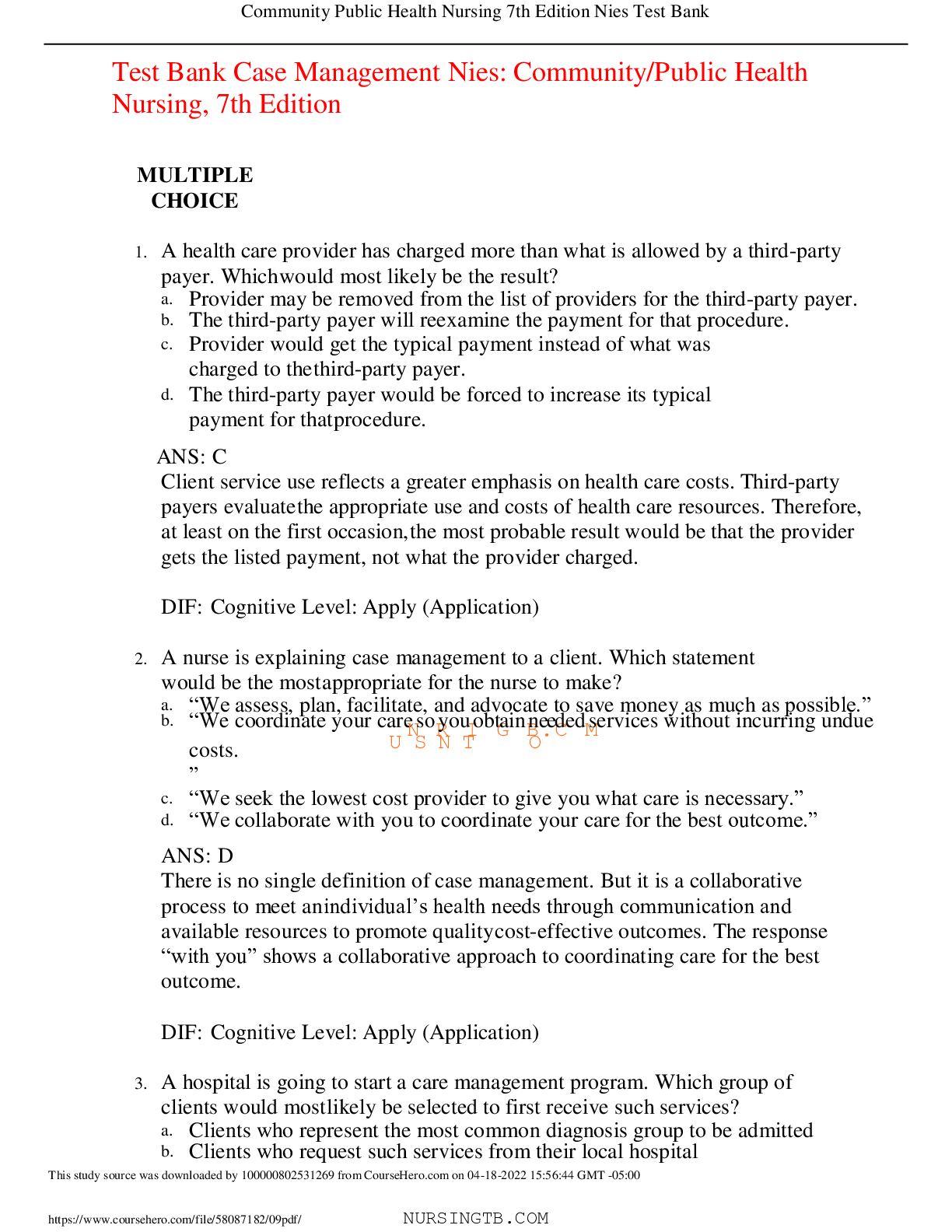


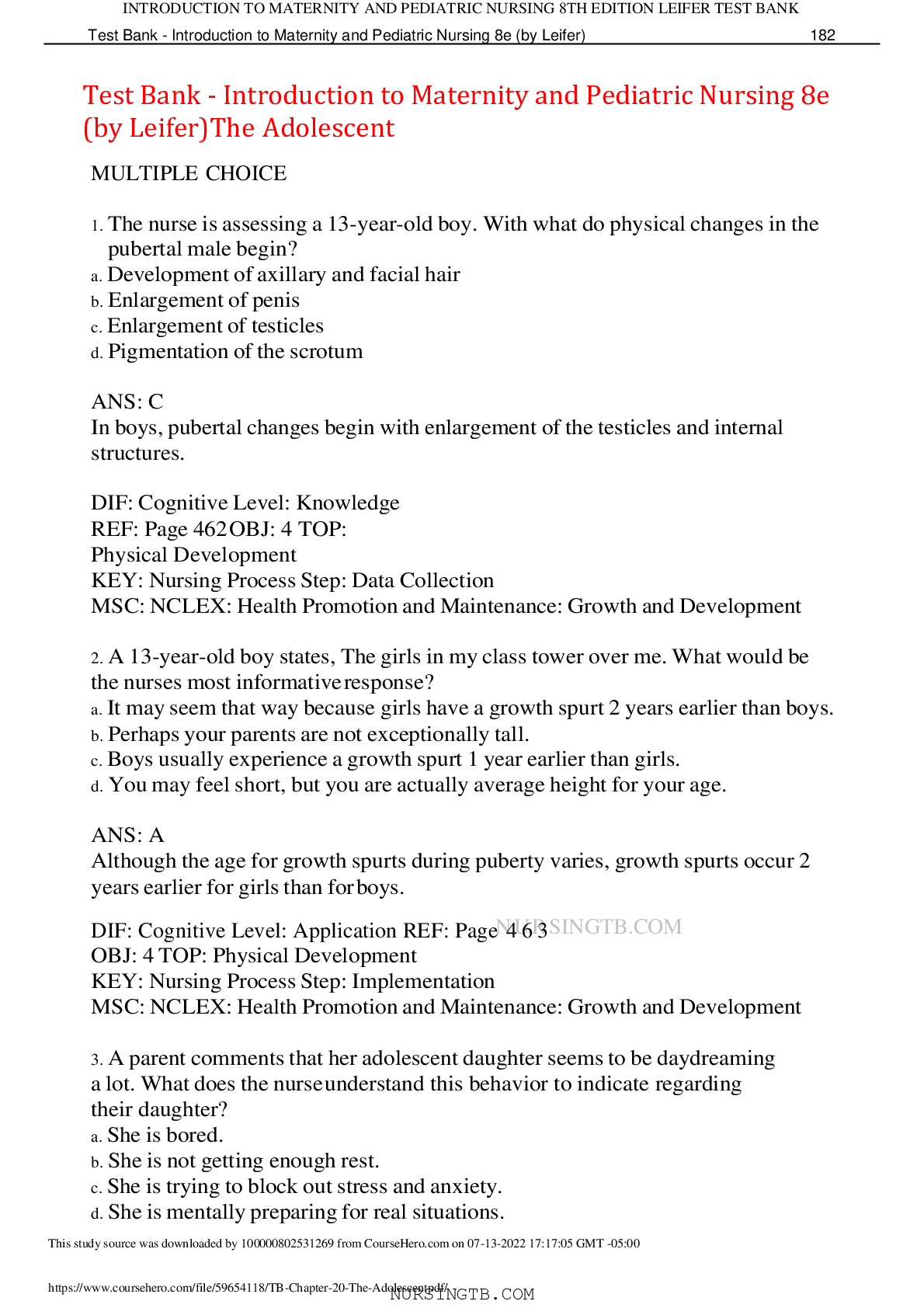
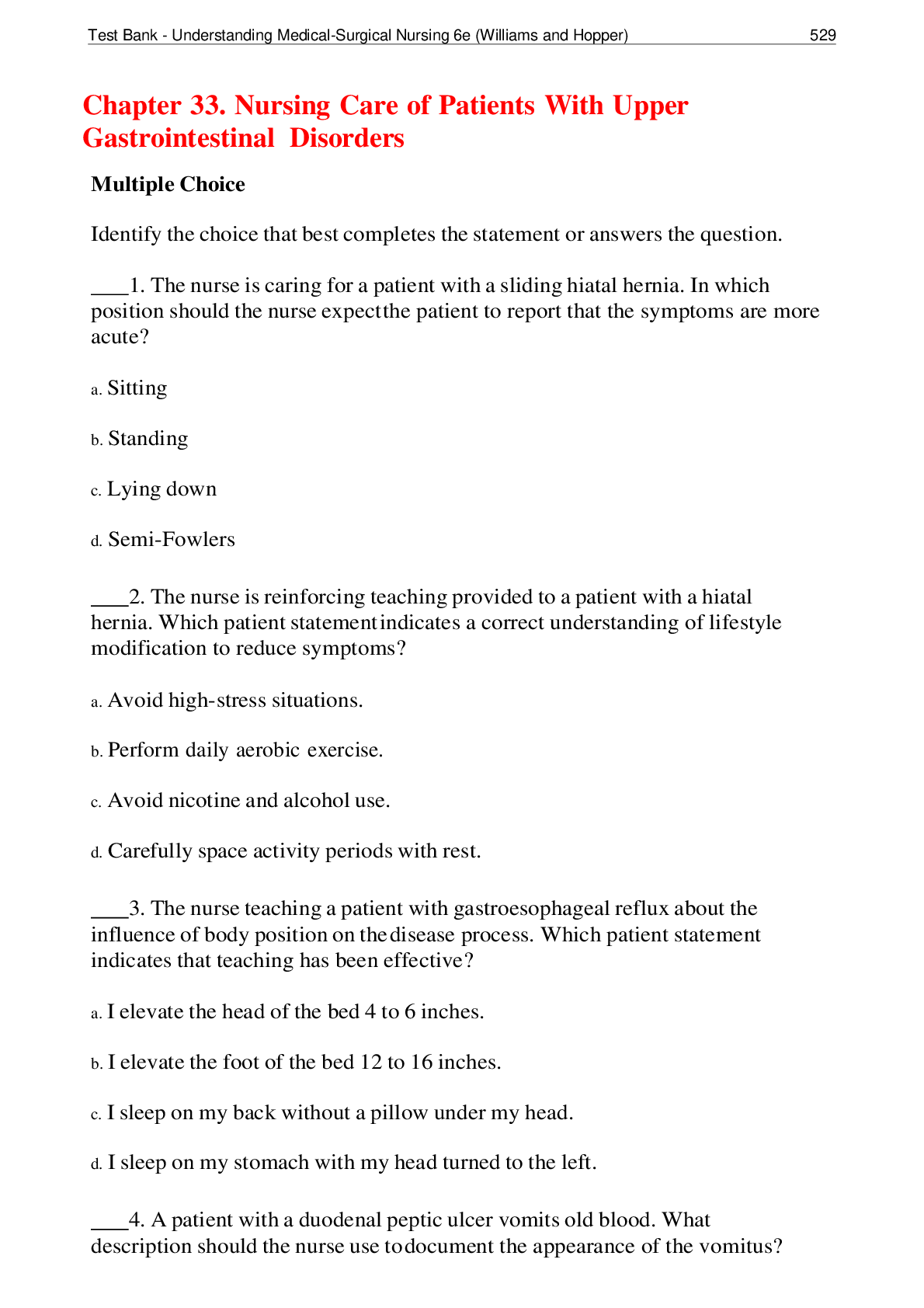
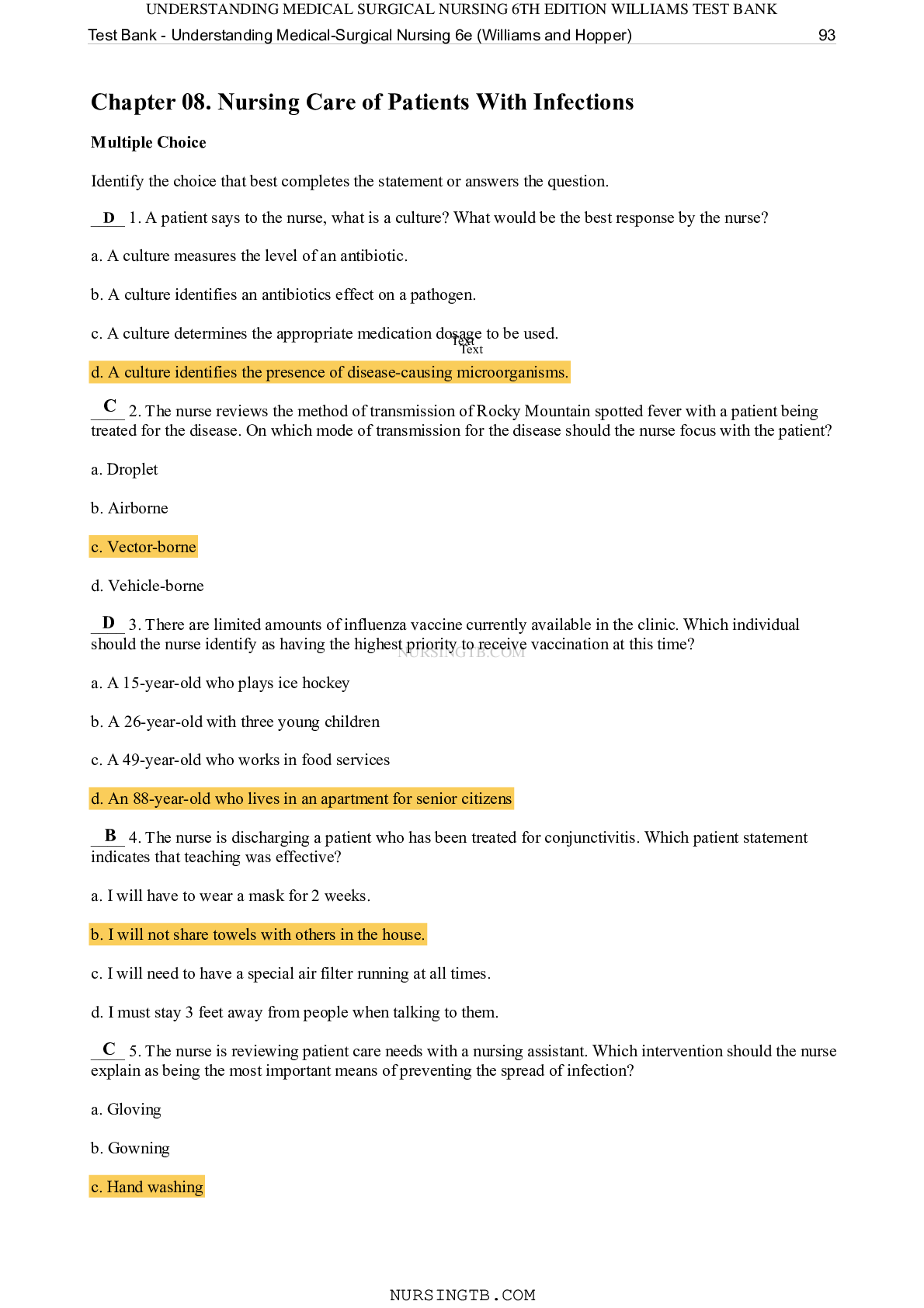
.png)

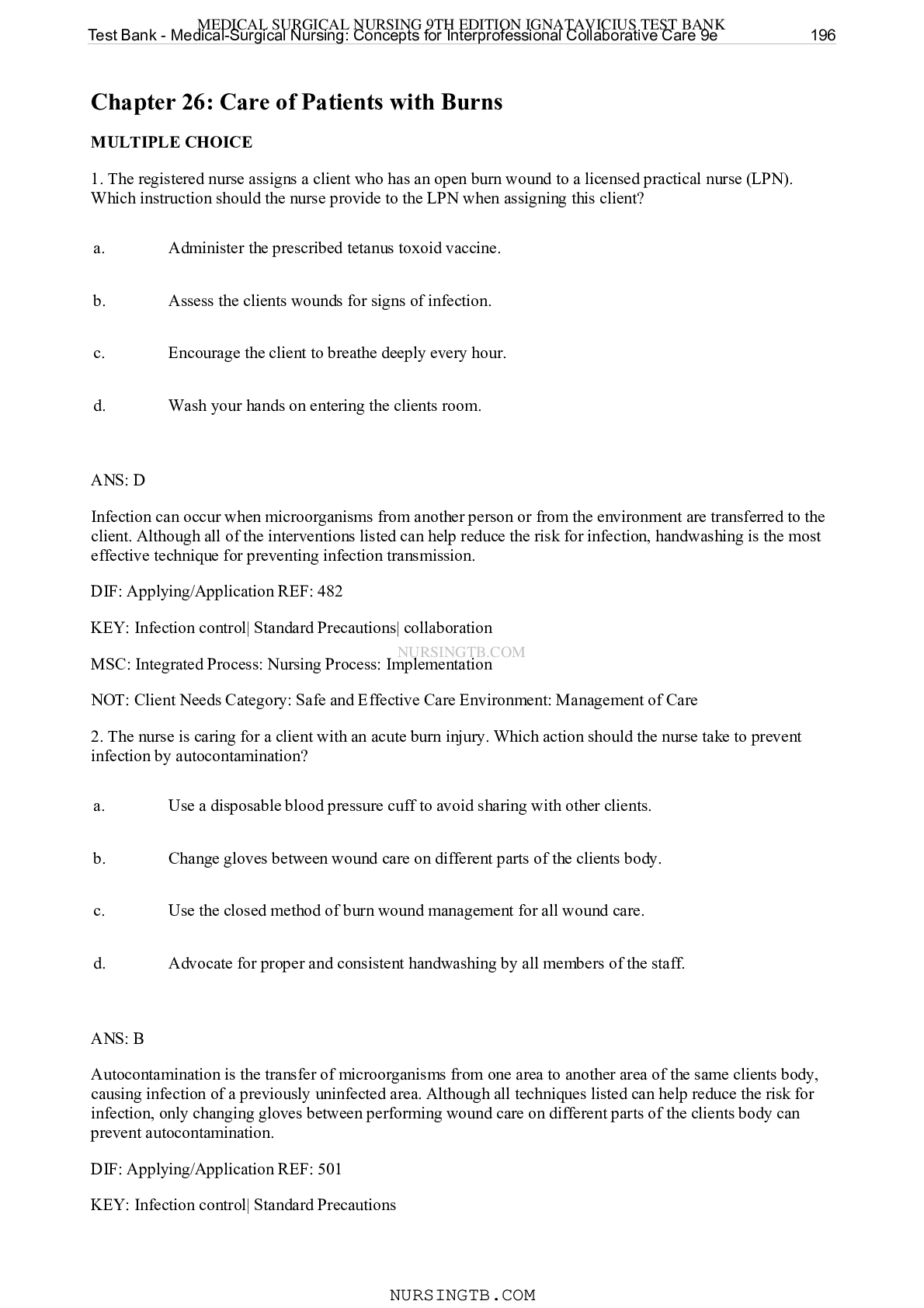




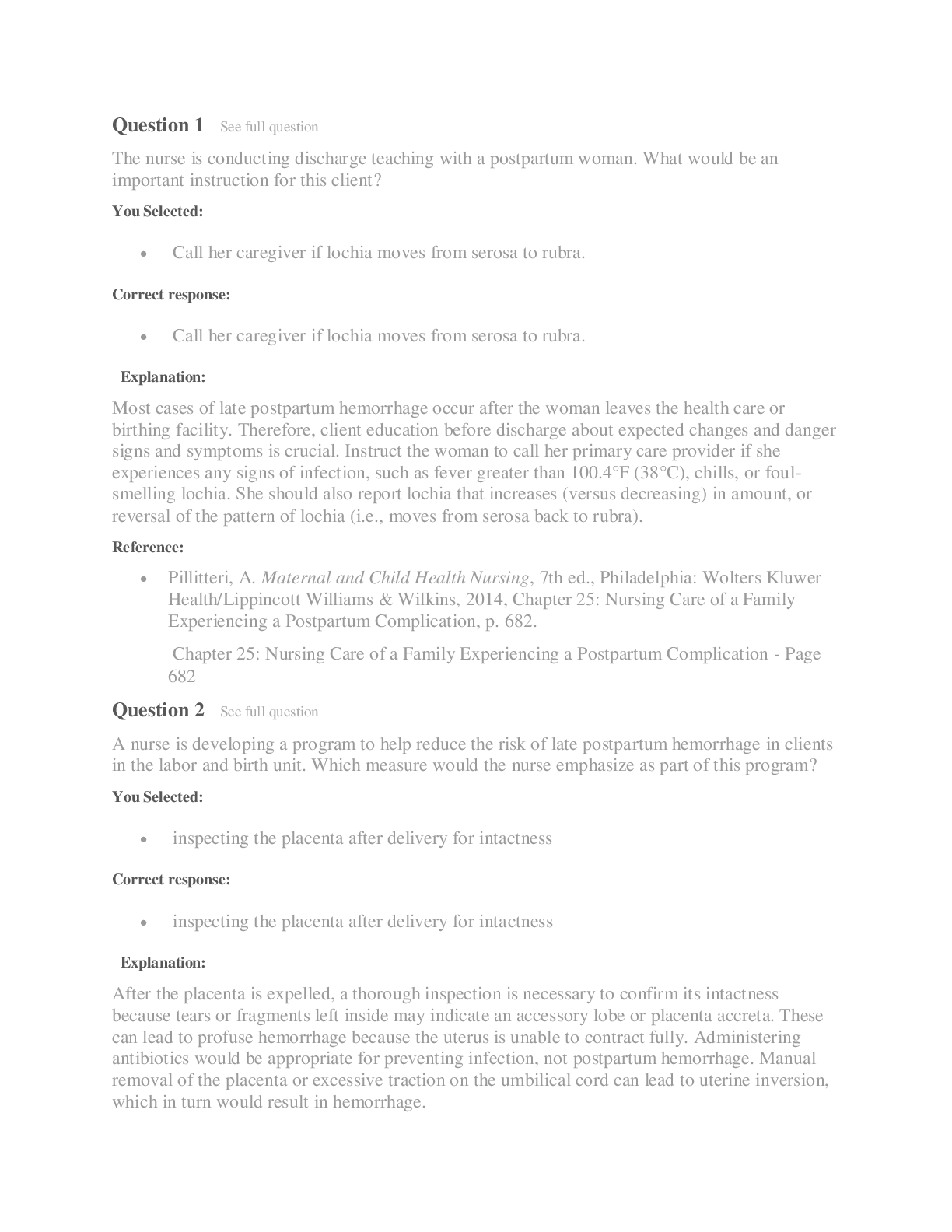

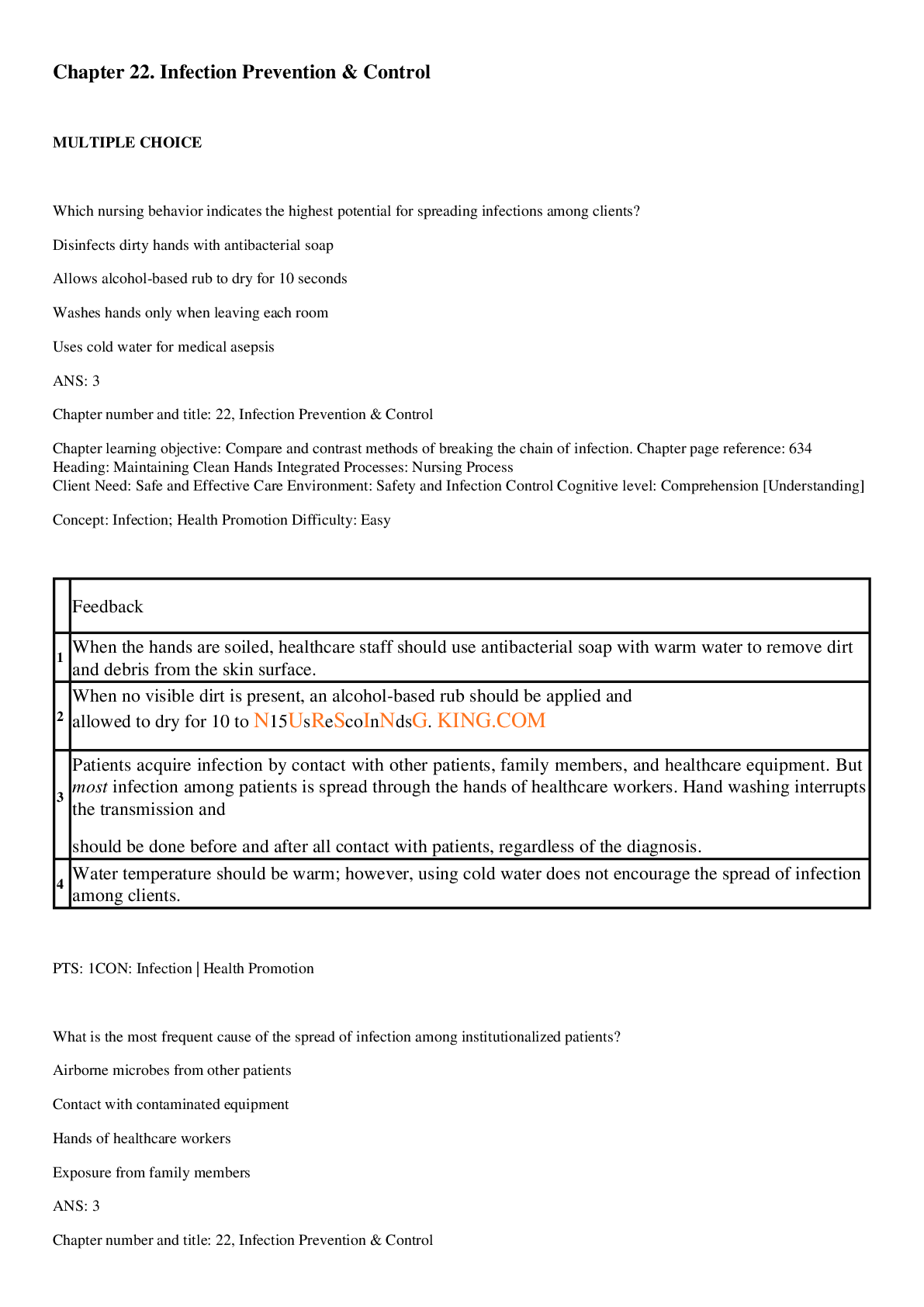
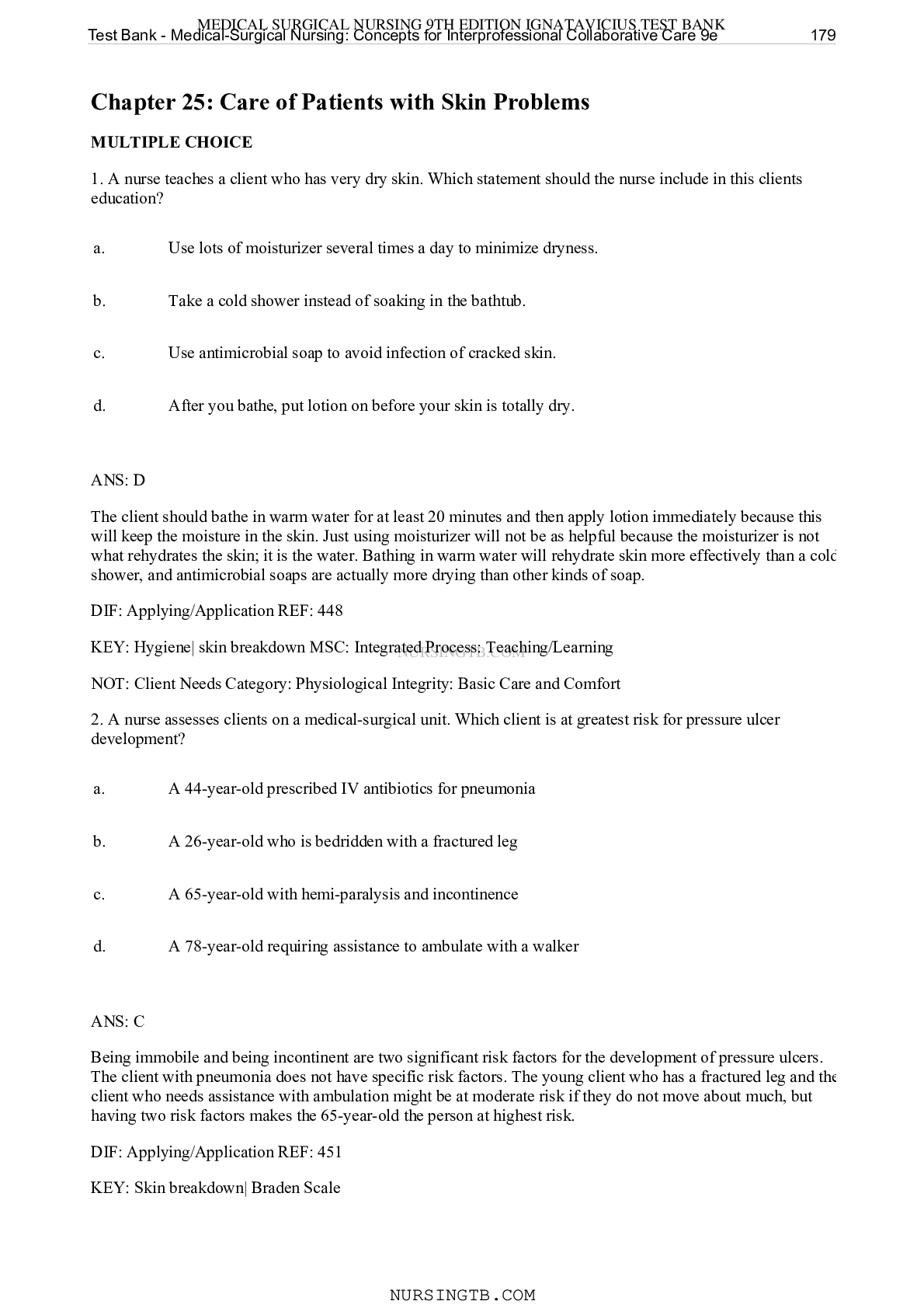

.png)

